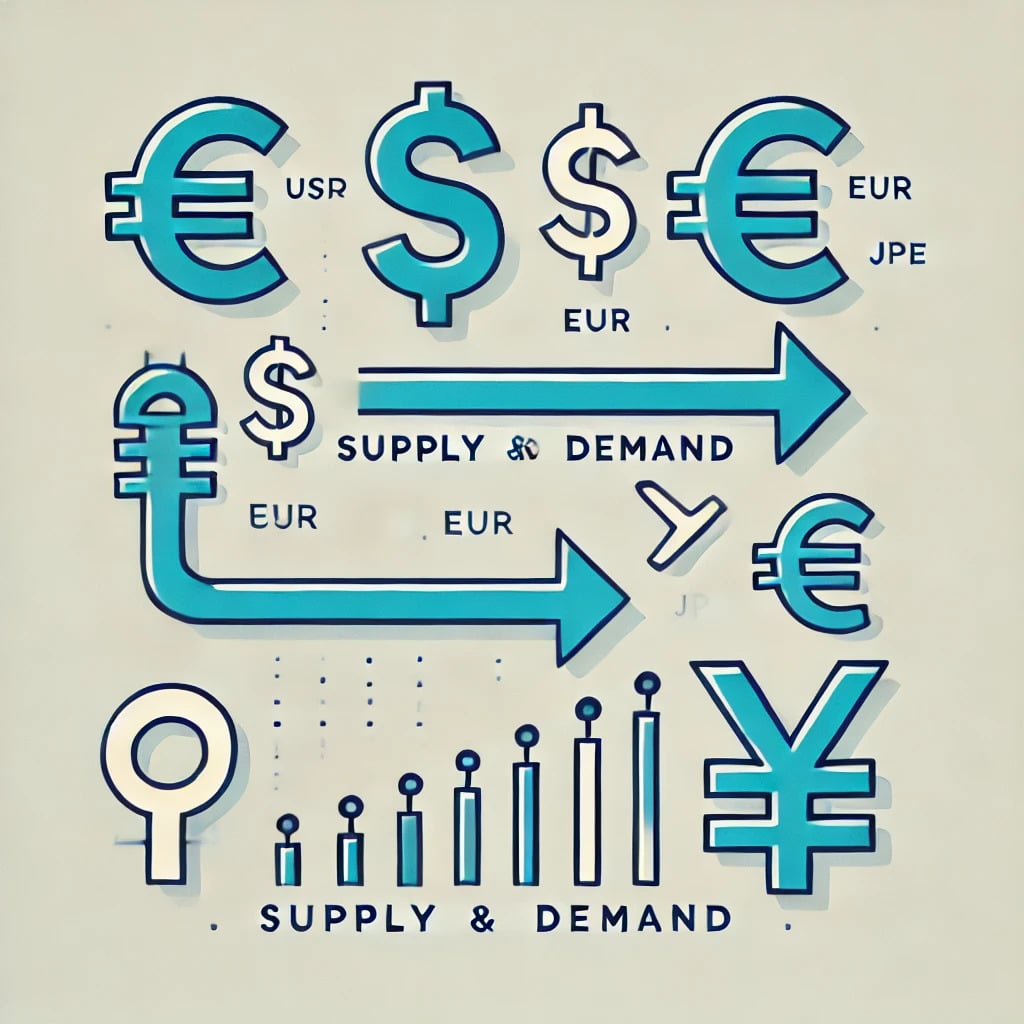
Understanding supply and demand is crucial for success in the forex market. Supply and demand are the driving forces behind changes in price. Hence, analyzing these forces can help traders identify potential entry and exit points for trades.

Prices rise with more buyers and fall with more sellers, creating supply and demand zones from imbalances. Prices move until balance is restored. Identify these zones by analyzing price history for significant moves from current levels.
Key Takeaways:
- Supply and demand drive changes in price in the forex market.
- Analyzing supply and demand zones can help traders identify potential trade opportunities.
- Supply zones indicate an imbalance with more sellers than buyers, leading to a potential price decrease.
- Demand zones indicate an imbalance with more buyers than sellers, leading to a potential price increase.
- Understanding supply and demand is essential for successful forex trading.
What is Supply and Demand in Forex
In forex trading, the balance between buyers and sellers drives market movements. Supply represents sellers willing to trade a currency at a certain price, while demand represents buyers seeking to acquire it at that price. This balance sets the market price.
For example, positive economic news about a country can increase demand for its currency. With more buyers than sellers, prices rise as sellers respond to the higher demand by raising prices
The Importance of Bid and Ask Prices
Understanding the interplay between buyers and sellers is crucial for successful trading. The bid price is the maximum price a buyer is willing to pay, while the ask price is the minimum price a seller will accept. The current market price is where these two prices meet.
Market Reactions to Global Events
Consider a scenario where a significant global event causes negative sentiments about a particular currency. Many sellers may flood the market, creating a surplus in supply. With more sellers than buyers, prices can spiral downward. To attract buyers, sellers might offer their currency at a discount, leading to a market correction.
Strategic Advantage in Forex Trading
Understanding the dynamics between buyers and sellers in forex trading is like decoding the market’s language. This knowledge helps traders anticipate shifts in supply and demand, giving them a strategic advantage in navigating the ever-changing forex market.
The Wealth-Driven Pendulum of Forex Markets
In the vast landscape of forex markets, the ebb and flow of currency valuation are intimately tied to the collective wealth and decisions of traders. This section delves into how the wealth of traders sets the pendulum of forex markets in motion, influencing the intricate dance between supply and demand.
The Role of Trader Sentiment in Currency Valuation
A pivotal factor in currency valuation is the collective sentiment of traders towards a specific currency pair. This sentiment is heavily influenced by economic indicators, geopolitical events, and central bank policies.
Impact of Interest Rate Decisions
Consider when the Bank of England announces an interest rate decision, a critical event that can sway sentiment towards the GBP/USD pair. If the decision aligns with market expectations and is perceived positively, traders may flood the market with buy orders, increasing demand for the British Pound and initially raising the pair’s valuation.
Market Correction and Profit-Taking
However, as the market reacts to the influx of buyers, the GBP/USD pair may become overpriced in the eyes of some traders. Sellers, recognizing the potential for profit-taking, enter the market, increasing supply. This shift in dynamics can lead to a gradual decrease in the currency pair’s value as sellers adjust their asking prices to attract buyers.
The US Dollar: Its Significance in Global Markets
The wealth-driven pendulum of forex markets is also evident in the global dominance of the US dollar. The majority of forex transactions worldwide, even those not involving the USD as part of the currency pair, are processed using US dollars. This highlights the influence of the US dollar’s supply and demand factors on the entire forex market. For instance, if there is a surge in demand for the US dollar due to global economic uncertainties, it can lead to an appreciation of the dollar against other currencies.
How to Identify Supply and Demand Zones in Forex
Supply and demand zones play a crucial role in forex trading, as they provide valuable insights into potential market trends and price reversals. By understanding how to identify these zones on forex charts, traders can make more informed trading decisions and increase their chances of success.
Identifying Balanced and Breakout Zones
One way to identify supply and demand zones is by looking for balanced and breakout zones on forex charts. A balanced zone occurs when the price is ranging, and buyers and sellers are in equilibrium. It is characterized by a consolidation phase where the price moves within a specific range.
“A balanced zone is a consolidation zone where the price is ranging and buyers and sellers are in balance.”
A breakout zone, on the other hand, occurs when the price breaks out of the range, indicating a shift in supply or demand. This breakout could signal an increasing demand for the currency pair, leading to a potential price increase, or it could indicate an increasing supply, resulting in a potential price decrease.
“A breakout zone occurs when the price breaks out of the range, indicating either an increasing demand or an increasing supply.”
Identifying Demand and Supply Zones
To identify a demand zone, traders look for specific patterns on the forex chart. A demand zone is typically characterized by large green candles with long wicks, indicating bullish sentiment. These zones often occur after a price dip and are lower than the previous levels.
“Traders look for large green candles with long wicks that indicate a bullish sentiment to identify a demand zone.”
On the other hand, a supply zone is identified by large red candles with long wicks, indicating a downtrend. Supply zones usually occur after the price has peaked higher than previous levels.
“A supply zone is identified by large red candles with long wicks that indicate a downtrend.”
Determining the Significance of Supply and Demand Zones
The significance of a supply or demand zone is determined by the strength of the price move and the time it stays away from the zone. A strong move in price and a longer duration away from the zone indicate a more significant zone.
Benefits of Identifying Supply and Demand Zones
Identifying supply and demand zones in forex is crucial for effective trade planning. By identifying these zones, traders can:
- Plan their entry points into trades
- Set appropriate stop-loss levels to protect against potential losses
- Determine take-profit levels based on the first demand level when shorting and the first support level when going long
Overall, understanding how to identify supply and demand zones in forex provides traders with a powerful strategy for analyzing the market and making informed trading decisions.
The Importance of Supply and Demand in Forex Trading
| Aspect | Description |
|---|---|
| Importance | Understanding supply and demand is essential for successful forex trading. These forces drive price changes and provide valuable insights for traders. |
| Analysis | By analyzing supply and demand zones on forex charts, traders can identify market trends and anticipate potential price reversals. |
| Strategy | Supply and demand trading involves buying at demand zones when prices are low and selling at supply zones when prices are high. |
| Entry Point | Traders enter the market at the breakout level of the zone, confirming an imbalance between buyers and sellers. |
| Risk Management | To manage risk, stop-loss levels are set beyond the extreme end of the zone, while take-profit levels are placed at the first demand level for shorting and the first support level for going long. |
| Success Factors | Accurate identification of supply and demand zones and understanding the market’s current phase (accumulation, markup, distribution, markdown) are crucial for success. |
| Timeframe Consideration | Traders must consider the timeframe that aligns with their trading style, taking into account factors such as liquidity and volatility. |
Supply and demand are the driving forces behind changes in price in the forex market. When there are more buyers than sellers, the market price will increase, and when there are more sellers than buyers, the market price will decrease.
[/wpsm_accordion_section]How can I identify supply and demand zones in forex?
Supply and demand zones can be identified by analyzing price history and looking for significant moves from current price levels. Traders can look for balanced and breakout zones on forex charts to identify potential supply and demand areas.
Why is understanding supply and demand important in forex trading?
Understanding supply and demand is crucial for analyzing forex charts and identifying potential entry and exit points for trades. By identifying supply and demand zones, traders can plan their entry, set stop-loss levels, and determine take-profit levels.
How do I use supply and demand analysis in forex trading?
Supply and demand trading relies on buying low at demand zones and selling high at supply zones. Traders enter the market at the breakout level of the zone, set stop-loss levels beyond the zone, and set take-profit levels at the first demand level when shorting and the first support level when going long.
What factors should I consider when identifying supply and demand zones in forex?
The strength of the price move and the time it stays away from the zone determine the significance of the supply or demand zone. Traders should also consider the market’s current phase, such as accumulation, markup, distribution, or markdown, and choose a timeframe that suits their trading style.

















